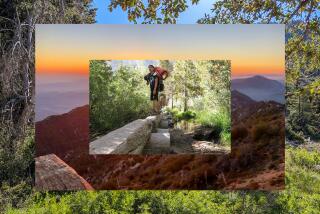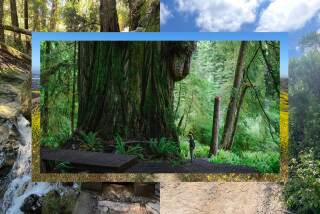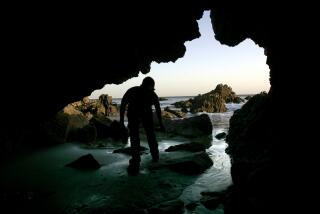Hollywood has vested interest in keeping state parks open
- Share via
Along with sunny weather and world-class crews, California offers something else sought by filmmakers: an abundance of state parks with diverse landscapes, from the redwood forests in Northern California to the desert of Anza-Borrego and the vast beaches and rocky coves of Point Dume.
Not surprisingly, the beauty and variety of the state’s 278 parks have provided countless backdrops for movies, TV shows and commercials for a century. In 2009 alone, nearly 500 permits were issued for nearly 1,000 days of filming in state parks for various productions, including “Iron Man 2” (Point Dume State Beach) and the romantic comedy “I Love You, Man” ( Leo Carrillo State Park).
There’s even an annual film series, hosted next month by the California State Parks Foundation, that highlights how Hollywood has relied on state parks as settings for such TV shows as the long-running “MASH” and films such as the 1968 classic “Planet of the Apes.”
But there’s growing concern in the film community that state parks, which and at risk of closing or falling into disrepair because of the state’s budget crisis, could get written out of the filmmaking script.
On Nov. 2, state residents will be voting on a ballot initiative, Proposition 21, that would require Californians to pay an extra $18 as part of their annual vehicle registration fee in exchange for eliminating day-pass fees at state parks. That may be a tough sell in the current economic climate, but proponents say California’s state parks need a reliable revenue stream to keep them open to the public and for commercial use.
Some of the biggest supporters of the initiative aren’t necessarily conservation groups — film commissions as well as location managers view the parks as an essential asset for filmmakers.
“The parks are beautiful, huge and diverse back lots for us,” said Veronique Vowell, chairman of the government affairs committee for the Location Managers Guild of America, which has endorsed the ballot initiative. “My concern is that if some of the parks were to close, it would be a disincentive to keep filming in California.”
In the last decade, production has been steadily leaving the state, thanks to the proliferation of tax credits and rebates offered elsewhere, although the migration slowed after California adopted its own film tax-credit program last year.
Vowell and other location managers see the parks as another selling point that helps keep jobs — and tax revenues — in the state.
There is evidence to back up the claim. State parks accounted for 62% of all film production permitted by the California Film Commission last year. “State parks have been an incredible source of locations over the years,” said Amy Lemisch, director of the California Film Commission.
Parks officials are certainly happy for the exposure. “It offers us a tremendous opportunity for us to promote our parks,” said Kris Lannin, who handles film issues on behalf of the California Department of Parks and Recreation.
Beyond diverse landscapes, parks are appealing because they provide inexpensive locations, Lemisch said. “If you were going to rent a private beach, I don’t know what it would cost.”
Parks don’t charge a permit fee. Filmmakers are required only to pay the salary of a park ranger who monitors the shoot and for any costs the parks incur during filming.
That’s a bargain, especially for producers of ultra-low-budget movies, such as Nancy Isaak, who recently filmed virtually all of her movie, a romantic thriller called “Symphoria,” at Malibu Creek State Park, one of most frequently used parks for filming.
“Shooting inside a state park is just ideal for us because it fits our budget but gives us a million-dollar look,” said Isaak, who had a small part in the film. She was standing under a canopy with her crew while filming a scene on a hilltop overlooking a pine forest that was chosen for the image it evoked of a Chinese landscape. In the film, the park is a favorite gathering place for a Chinese American family.
They also shot scenes at the park’s Century Lake and in front of giant fallen oak tree near a ravine that served as a famous backdrop for the brutal human roundup depicted in “Planet of the Apes.” They even used a parking lot to film a college campus scene.
“You get vistas that you can substitute for almost anything,” Isaak said.
More to Read
Inside the business of entertainment
The Wide Shot brings you news, analysis and insights on everything from streaming wars to production — and what it all means for the future.
You may occasionally receive promotional content from the Los Angeles Times.











